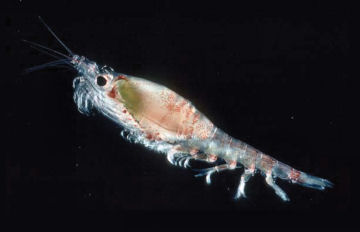Deep krill
Scientists were surprised to find Antarctic krill lurking at the bottom of the sea.
By Emily Sohn
A little over a year ago, scientists lowered a camera to the bottom of the Southern Ocean off the coast of Antarctica. The video images from that camera surprised them.
Three thousand meters (9,800 feet) below the surface of the sea, the researchers observed what looked like an animal called Antarctic krill. Scientists had thought these shrimplike creatures lived only in the upper ocean, says Andrew Clarke of the British Antarctic Survey based in Cambridge, England.
 |
|
This female krill, full of eggs, came from the surface of the Southern Ocean. Researchers have now glimpsed the same species at 3,000 m (9,800 feet) down.
|
| British Antarctic Survey |
Clarke made the discovery on a science cruise during the South Pole summer of 2006–2007 (a period which corresponds to the Northern Hemisphere’s winter). By that time of year, tiny floating organisms called plankton (a favorite food of krill) have multiplied in a big burst at the water’s surface. From there, they slowly drift downward.
Using a remotely operated vehicle that carried a video camera, Clarke and colleagues saw krill feeding on falling plankton. By studying the video footage, they identified the krill as the classic Antarctic species, Euphausia superba.
The species was fairly easy to identify. It is relatively large, for one thing, growing up to 6 centimeters (2.4 inches) long. It has distinctive red markings. And it feeds in an unusual way when it’s near the bottom. A krill nosedives into the sediment at the bottom, then scoops debris out of the water with spiny structures on its legs.
Based on the video evidence, “there isn’t really much else it could be” other than the Antarctic krill, says Stephen Nicol of the Australian Antarctica Division in Kingston, Tasmania.
Scientists have occasionally spotted this species of krill several hundred meters deep, but never in water as deep as this. So, the scientists are not exactly sure what’s going on. One possibility is that the krill simply stuck with their food as it sank ever deeper.
If big groups of krill do this often, scientists might have to revise their ideas about how many krill there are and how nutrients move through oceans.
“If the observation proves true about the krill at 3000 m,” writes Peter Wiebe of the Woods Hole Oceanographic Institution in Massachusetts (who’s currently on a different research expedition), “then it shows how little we really understand about how the ocean ecosystem is structured and functions.”







